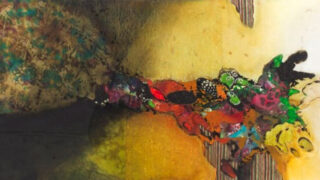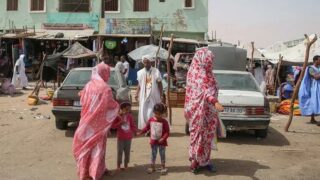Mauritania's opposition parties sought to “overthrow the regime” and ride the waves that have been spreading throughout the region for a little more than two years, yet they did not succeed.
While this endeavor may have been curbed by the developments of the country’s nearby sister (Libya), as well as by the state of affairs in other countries, there are also other possible explanations. But the reasons that prompted these parties to start popular protests in Mauritania are still there, along with other unique issues, just like in any other country. Foremost among those unique issues is slavery, or servitude, a term that has been used frequently in the Western media and in reports issued by international and local human rights organizations.
This is an issue that raises many sensitivities, and it specifically collides with the complexities of Mauritania’s demography in terms of the country's ethnic groups, as well as in terms of the hierarchy according to which each and every one of those groups is distributed. Add to this the difficulty of using reliable numbers or statistics, as no official census has been taken in the past 30-odd years due to another problem related to the disclosure of the majority in the composition of the population. For instance, there are black Arabs [in addition to Mauritanians of African descent], and this complicates the issue and no longer confines it to a simple division between white- and black-skinned people.
A structure made up of colors and races
Mauritanian society comprises four ethnic groups. There are Arabs (white and black), and in total they make up about two-thirds of the population, which amounts to about 3.5 million people. There are also three non-Arab African groups, which are the Wolof, the Fula and the Soninke. Since Mauritania gained independence in 1960, and more specifically since the late 1980s, the Arabs and non-Arabs have been living in a state of semi-conflict whose severity varies according to the circumstances.
Mauritanians speak four different languages, but Arabic is the official language of the state. This, among other factors, increases the tensions between the groups of Mauritania.
The difference in language, however, is compensated for by a strong sense of belonging to the country and by the fact that the people belong to one religion; they are all Muslims who follow the Maliki School of jurisprudence. They are all subject to a hierarchy that separates and differentiates between them. This hierarchy varies based on regions and ethnic groups, and it also has varied through time. There are the “Bedouins,” who are Arabs, and these include people who carry weapons. These people are generally called “the Arabs,” and they are the warriors. There are also the “Zawaya,” who are the religious science teachers, including the “Shoorafaa” who believe that they are the descendants of the Prophet Muhammad. There are the “Zanagha,” the majority of whom work as cattle farmers, and the “Khodri,” (i.e., the green people), who are black-skinned Arabs who have multiple origins. Some of them were black tribes who lived in the country prior to the Arab conquest; they intermarried with Arabs and became Arabs. Others were slaves who were enslaved and freed in different ways. Then there are the “Moallimoon” — i.e., artists and craftsmen — who include famous singers. There are the “Lahama,” who take personal care of their masters and give them massages or defend them with words, as they are known to use their insolent words to achieve what they are asked to do. Each tribe has its masters, and these masters use the Zawaya as teachers for their children, the Lahama to take care of their comfort and body, slaves to prepare food and manage the household affairs, craftsmen to manufacture what they need, and singers to sing to them and praise them.
These appellations, albeit different from one language to another, do not differ in the division of ranks and functions within each group. The bottom line is that slavery exists among all the different groups of this country, but it has different labels due to linguistic differences. Slaves are Arabs for the Arabs, blacks for the non-Arab blacks — and the latter may be suffering from the most miserable condition. For the Soninke, for example, masters and slaves do not pray together, do not eat together and are not buried together. This, however, is not the case for Arabs.
Given this structure, slavery became a prominent issue, leading to the formation of [anti-slavery] movements and associations. Furthermore, Mauritania is facing both internal and external pressures when it comes to slavery, given that slavery is an obsolete issue that has become part of the past for human history and it cannot be practiced anymore.
A heavy colonial legacy
Looking to the past, we find that the oldest reference to slavery [in Mauritania] dates to 1493, when this phenomenon was spread through kidnappings, the purchase of slaves from neighboring peoples, invasion, and those enslaved for not paying taxes. There were some attempts to get rid of this practice in the past. For example, in 1673, the Movement of Repentance was established by Imam Nasir al-Din to “forbid the sale of slaves to Christians” such as Europeans who had begun their campaign to acquire slaves from Africa. Also, there were many jurisprudential opinions questioning the legitimacy of slavery, based on the fact that the way it is practiced in Mauritania is contrary to Islamic Sharia law, which permits slavery only when someone is imprisoned in times of war.
But the practice remained and these fatwas fell on deaf ears. The French-British conflict came to join this issue. England asked France to stop the slave trade in 1817 as a condition for it to give the latter Saint-Louis in Senegal.
But the intercontinental slave trade continued until the early 20th century, with traders using rivers to transport the enslaved. In 1848, France issued decrees to abolish slavery in all of its colonies, whereby fugitive slaves shall not return to their former masters, and all practices which oppose the spirit of the laws and principles of the French Revolution shall be rejected. But the laws were far from being applied, and the balance of power in Mauritania resolved the issue in favor of the Bedouins, to whom France renewed their slavery privileges. Thus, the French occupiers mediated, allowing the Bedouins to continue to trade, albeit under a mask.
Independence
After independence, the Mauritanian government inherited a society of firm Bedouin values. This society neither knew the meaning of institutions nor a modern state. The successive governments treated slaves as a labor force that is essential for the continuation of the traditional economy. Their tasks included serving as shepherds, planting, plowing and doing household chores. These governments felt that the issue would be solved over time, as they used to say. They did not seriously seek to implement the agreements and covenants that were issued by the French colonial authorities, nor those issued by the independence governments. This is despite the fact that the first president of Mauritania, Moktar Ould Daddah, noted in his memoirs that this issue would either lead to an armed conflict that destroys the country, or to societal change that can evolve with time. The legal procedures remained frozen in all the governments that followed the Ould Dada era, although the military authorities issued a circular in 1981 stating that the practice of slavery is illegal and that it must end.
During the era of President Mohamed Khouna Ould Haidalla, an anti-slavery law was issued, which included financial compensation to be provided to slave masters. Traditional leaders widely objected to this move, and they were not willing to free their slaves, even in return for compensation. In any case, this law contradicted the 1958 Constitution, which stipulated total equality between citizens and burdened the government with charges that it was not able to pay.
During the days of Maaouya Ould Sid'Ahmed Taya (1984-2005), this issue took a different path, as the government worked to integrate the Haratine into society. Haratine was the name given to slaves after their liberation. These efforts included assigning governmental posts to influential figures in this field, and Messaoud Ould Boulkheir, [a Haratine himself] and the head of the Akhouk al-Haratine Movement, was appointed minister of culture. The word Haratine meant, among other things, “freed slave,” or the slave who recently gained his freedom, and was used as a reminder that slaves were originally freemen and were enslaved illegitimately.
Since 2006, laws criminalizing and punishing slavery practices have been issued. Furthermore, the National Agency to Fight the Effects of Slavery, Poverty and Integration was established, but, according to its secretary-general, it did not introduce anything new compared to the previous national laws. In fact, all the issued laws remained powerless in influencing this issue, given the lack of follow-up or implementation mechanisms.
One problematic issue
It is interesting that the issue of slavery, when raised, is often blamed on white Arabs. Talk of slavery among black communities is absent from discussions and not published in the media. This is true even though racism and slavery practices were tougher and more violent in black societies, especially among Soninke ethnicities. The reasons for this discrepancy might include the similarity in color between blacks and masters in this society. Moreover, international organizations have focused on general injustices facing blacks. This has prevented the discussion of the issue of slavery in black societies, where a lack of interest in the topic is obvious. Furthermore, some are suspicious of the political agendas supported by foreign countries, which are manipulating this issue to mess with political stability in Mauritania. Yet this does not negate the initial problem.
An unsolvable problem?
Many of those interested in the matter note that slavery is no longer a real issue, except in remote rural areas plagued by poverty and illiteracy. In any case, the solution cannot be reached through isolating the issue of slavery from the cultural and social heritage of Mauritania. In addition to its economic role, slavery constitutes a part of Mauritanian ideas and traditions. It cannot be fixed only through laws, but require addressing the issues that feed this mindset — first and foremost illiteracy. Moreover, equal opportunities should be provided to all groups, allowing them to occupy positions and jobs in the government and its institutions.
The role of imams and religious scholars is as influential as that of laws and decrees. For this reason, a clear and categorical religious discourse that forbids this practice must be adopted. Moreover, it is necessary to steer clear, first and foremost, of violent approaches in dealing with the subject because “such behavior harms the issue itself and the nation as a whole,” according to Boulkheir, head of the National Council. The issue must become a national concern, not only confined to one group. It should also be left out of the political conflict between the regime and the opposition, as this burdensome legacy (slavery) cannot be blamed on one entity alone, but is rather the responsibility of all citizens.
Translated by Al-Monitor



